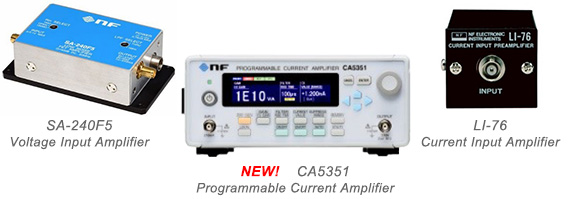03/11/2020 posted

The Improvements of signal-to-noise ratio (SNR) is very important in small signals
measurements. And preamplifiers are used to amplify signals when they are affected by noise,
generally in sensor-based measurements, where the purpose is to improve the SNR. Yet, on the
other hand, preamplifiers are sometimes used to change the output impedance of sensors as
well.
Choosing an appropriate preamplifier based on the purpose of application is the key to
measure signals from sensors with better quality.
Because there are various requirements for different measurements, it is necessary to choose
a correct preamplifier based on the type of sensor used.
In the case of thermal sensors, we normally choose a voltage-input type preamplifier,
because the sensors typically provide voltage outputs. In the case of photodiodes, a
current-input type preamplifier would be suitable because the photodiodes for photodetection
provides current outputs.
Furthermore, the requirements for preamplifiers' output signals may vary depending on the
purpose of application. At the same time, high-speed response is necessary for image
processing, low noise is required for spectroscopic measurements of semiconductor properties
and so on.
Other manufacturers often offer preamplifiers with narrow bandwidth which is specified in a particular frequency range. They are only effective in the specified frequency range, thus a different preamplifier for each particular frequency range is required if you wish to measure in many different frequencies.

Figure.1 Equivalent Input Noise Voltage Density against Cut-off Frequency

Figure.2 Equivalent Input Noise Voltage Density against Input Impedance
NF's preamplifiers have a wide bandwidth and low noise, so they can
be used to measure a wide range of frequencies. NF also offers FRA (Frequency Response
Analyzer) and lock-in amplifiers that can measure in a wide frequency range. These wide
bandwidth and low noise preamplifiers are suitable to use in combination with wide frequency
measuring instruments.
Conversely, if the preamplifier bandwidth is wide and noise increases, it can be combined with a filter that limits the frequency band to reduce noise. NF offers multiple types of filters that can fit various applications as well. Not only the preamplifier, but the combination of other devices can also fulfill the requirements.
There are so many different factors need to be considered when it comes to selecting the perfect product, but the main ones you absolutely need to know are right here:
Selection depending on the sensor outputs, whether voltage output or current output.
If only the AC signal is needed, DC signals need to be cut by an AC coupled preamplifier. In low frequency measurements, a DC coupled preamplifier is required because AC coupled preamplifiers cannot amplify low frequency signals.
The differential output type sensor can reduce the influence of noise caused by the GND line, but the maximum effect can be obtained by combining it with the differential input type preamplifier.
Even with a voltage output type sensor, the impedance of the sensor may be large or small. The input impedance of the preamplifier depends on whether the input element is a FET or a bipolar transistor, a suitable type needs to be selected for the sensor.
If fast response is important, use a wide frequency band preamplifier. On the other hand, in the case of low frequency measurement, noise may be reduced by using a preamplifier in the corresponding band.
Recent post